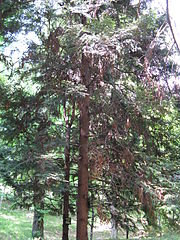Difference between revisions of "Thujopsis dolabrata"
m (moved Thujopsis to Thujopsis dolobrata: only species in genus) |
|
(No difference)
| |
Revision as of 19:00, 21 August 2009
| Origin: | ✈ | ? |
|---|
| Exposure: | ☼ | ?"?" is not in the list (sun, part-sun, shade, unknown) of allowed values for the "Exposure" property. |
|---|---|---|
| Water: | ◍ | ?"?" is not in the list (wet, moist, moderate, dry, less when dormant) of allowed values for the "Water" property. |
Thujopsis (Greek, Thuja-like)CH. Also spelled ThuyopsisCH. Pinaceae. Ornamental tree or shrub grown chiefly for its handsome evergreen foliage and the formal habitCH. The sole member of the genus being Thujopsis dolabratawp
Read about Thujopsis dolabrata in the Standard Cyclopedia of Horticulture
|
|---|
|
A tree closely related to Thuja and chiefly distinguished by the broader much flattened branchlets and by its conelets having 3-5 winged seeds under each scale.—Only one Japanese species. Its yellowish white close and straight-grained wood is very durable and is used in Japan in boat- and bridge-building. Thujopsis is one of the most beautiful Japanese conifers and forms a pyramidal tree, in cultivation sometimes shrubby, with spreading branches, the branchlets arranged in a frond-like fashion, much flattened and clothed with scale-like glossy green foliage. It is well adapted for planting as a single specimen on the lawn wherever it can be grown successfully. It is hardy as far north as Massachusetts, but usually suffers from summer drought. It thrives best in a sheltered and shaded position and in moist loamy soil, and seems to grow to perfection only in cool and moist climates. Propagation is by seeds, also by cuttings and by grafting like thuja. Plants raised from cuttings usually grow into bushy round-headed plants. Plants grafted on thuja are said to be short-lived. Seedlings are therefore to be preferred. CH
|
Cultivation
- Do you have cultivation info on this plant? Edit this section!
Propagation
- Do you have propagation info on this plant? Edit this section!
Pests and diseases
- Do you have pest and disease info on this plant? Edit this section!
Species
Gallery
If you have a photo of this plant, please upload it! Plus, there may be other photos available for you to add.
References
- Standard Cyclopedia of Horticulture, by L. H. Bailey, MacMillan Co., 1963
External links
- w:Thujopsis dolabrata. Some of the material on this page may be from Wikipedia, under the Creative Commons license.
- Thujopsis dolabrata QR Code (Size 50, 100, 200, 500)

